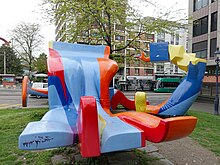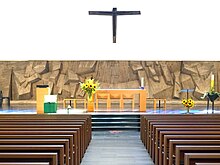Michael Grossert
Michael Grossert ( fully Alois Josef Michael Grossert ; born January 31, 1927 in Sursee ; † March 9, 2014 in Paris ; resident in Grossdietwil ( canton Lucerne )) was a Swiss artist with a diverse work style. Grossert has constantly developed his work in terms of technology and form in order to find new ways of representing space and perception.
life and work
After completing his apprenticeship as a carpenter, Michael Grossert began training at the Lucerne School of Applied Arts in 1948 . From 1949 to 1953 he worked in Albert Schilling's studio in Arlesheim and attended courses at the Basel School of Applied Arts . Grossert lived in Basel from 1953 and married Gertrude Kirowitz in 1954. They had two daughters together. From 1955 to 1960 he was a drawing teacher at the secondary school in Sursee and from 1960 to 1966 he was a drawing teacher at the grammar school in Aarau .
After his first stay in Paris in 1963, he emigrated there with his family in 1966. He showed his work regularly at the Salons Jeune Sculpture (from 1966), Réalités Nouvelles (from 1969) and at the Salon de Mai (from 1972). Grossert's artistic fields include sculpture, installation, painting, printmaking, drawing, glass windows, multiples, lithography, video, screen printing, building design, environment, sculpture, public art and conceptual art. After figurative beginnings in cement, stone and plaster, he developed an increasingly abstract design language at the end of the 1950s. In the early 1960s, objects became more moving and interacted more closely with space. The same phase includes works in which the arrangement of the objects optically simulates a static imbalance. With the spatial horizons (1964/1965), the discontinuity of space becomes the artist's central theme; the volume sculptures are being replaced by spatial sculptures.

Around 1966 he discovered plastic as a color carrier that could be shaped as desired. The transformers (1966–1967), which can be composed in various ways, lead to polychrome polyester landscapes such as Zone infinie (1968) and Lieudit I (1970–1972). From 1972 Grossert dealt with reflections. Initially, a shaped plexiglass pane was used to refract light and space ( Reflexion d'espace II , 1973). Afterwards, works were created with a transparent mirror as a reflection and projection surface: the (images) of the opposing sculptural structures are superimposed on the glass partition.
From the mid-1970s, the visualization of perception processes was his main artistic concern. In his large room installations, the recipient is assigned an active role in the creation of immaterial images. Around 1980 works were added, the depth of which was created by staggering painted grids. In 1977, Grossert co-founded the «Gruppe Espasme» and from 1986 to 1992 a member of the central board of the GSBMA and since 1987 in the Comité Directeur des Salon de Mai . Exhibition activities at home and abroad.
In 1990 his studio and parts of his life's work were destroyed by fire. From 1991 he lived with Katja Lehr. They married in 1995 and had a son and a daughter together.
Works (selection)
- 1959: Church portal, aluminum, for the Catholic Church Brother Klaus, Winkeln near St. Gallen
- 1964: Concrete relief, for the Catholic Church of St. Nikolaus in Reinach, Basel-Landschaft
-
1967: Design of the playground for the Aumatten primary school in Reinach
 Concrete relief, 1964, Catholic Church St. Nikolaus, Reinach
Concrete relief, 1964, Catholic Church St. Nikolaus, Reinach - 1968: First colored polyester landscape Zone infinie I (destroyed)
- 1969: First room installation in the Kunsthalle Basel
- 1975: Lieudit polyester plastic, painted polyester; Heuwaage-Platz, Basel
- 1987: Design of the town hall forecourt with a fountain, Sursee
- 1993: Design of the inner courtyard, concrete, mirrors, transparent glass, colored metal elements, Port-Barcarès near Narbonne
- 1993: Design of the inner courtyard, administration building, Hoffmann-La Roche, Kaiseraugst
Exhibitions
- 1952: Exhibition at the Lucerne Art Museum
- 1971: Les Suisses de Paris, Aargauer Kunsthaus Aarau
- 1975: Retrospective at the Aargauer Kunsthaus, Aarau
- 1975: Swiss sculpture exhibition, Biel
- 1975: Galerie l'Enseigne du Cerceau, Paris.
- 1980: Grün 80 , Basel
- 1982: Retrospective in Sursee town hall
- 1985: Biennale of Swiss Art, Olten Art Museum
- 1994: Retrospectives in the Sursee town hall.
- 1999: Hannelore Lötscher Gallery, Lucerne
Prices
- 1952: Sponsorship award from the Federal Art Commission
- 1955: Sponsorship award from the Federal Art Commission
- 1966: Scholarship from the city of Basel
- 1966: Federal art grant
- 1970: Prix Adam de la Jeune Sculpture
- 1993: Prix de la Sculpture of the Académie des Beaux-Arts, Paris.
Sculpture Courtyard, 1967, Reinach
Web links
- Lucia Cavegn: Grossert, Michael. In: Sikart (as of: 2018), accessed on October 27, 2019.
- Michael Grossert architecture for children.
- Michael Grossert Basel Artists Society
- Michael Grossert In: Art Credit Collection
- Michael Grossert , obituary in the NZZ April 17, 2014
- Vanda Dürring: Michael Grossert, Art in Public Space, Polyesterplastik Lieudit In: SRF July 21, 2019
Individual evidence
- ↑ Architecture for Children: Architecture for Children. Retrieved May 4, 2019 .
- ↑ Sikart: plastic. Retrieved May 4, 2019 .
- ^ Basler Künstlergesellschaft: Exhibitions, Awards. Retrieved May 4, 2019 .
| personal data | |
|---|---|
| SURNAME | Grossert, Michael |
| ALTERNATIVE NAMES | Grossert, Alois Josef Michael (full name) |
| BRIEF DESCRIPTION | Swiss artist |
| DATE OF BIRTH | January 31, 1927 |
| PLACE OF BIRTH | Sursee |
| DATE OF DEATH | March 9, 2014 |
| Place of death | Paris |



